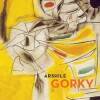
Door een staking bij bpost kan je online bestelling op dit moment iets langer onderweg zijn dan voorzien. Dringend iets nodig? Onze winkels ontvangen jou met open armen!
- Afhalen na 1 uur in een winkel met voorraad
- Gratis thuislevering in België vanaf € 30
- Ruim aanbod met 7 miljoen producten
Door een staking bij bpost kan je online bestelling op dit moment iets langer onderweg zijn dan voorzien. Dringend iets nodig? Onze winkels ontvangen jou met open armen!
- Afhalen na 1 uur in een winkel met voorraad
- Gratis thuislevering in België vanaf € 30
- Ruim aanbod met 7 miljoen producten
Zoeken
Omschrijving
Arshile Gorky (1904-48) is a pivotal figure in mid twentieth century American painting, providing a bridge between European modernism and the generation who established the New York School. Coinciding with a major retrospective exhibition of his work at Tate Modern, this succinct and accessible survey examines a career that began and ended with tragedy but that produced some of the greatest paintings of a generation. Gorky was born Vosdanik Adoian in Armenia, his family moving to the city of Van in 1910. When the Turkish army laid siege to Van in 1914, he took part in its defence, eventually fleeing 100 miles on foot with his sister and his mother, who died of starvation in Eastern Armenia in 1919. In 1920 the artist arrived as a refugee in New York with his sister, taking his second name from the Russian poet Maxim Gorky, whose cousin he sometimes claimed to be. He swiftly turned to art, studying and later teaching at the New School of Design in Boston. In the 1920s he produced two versions of his most famous early work, "The Artist and his Mother", derived from a single surviving family photograph. His later style wedded biomorphic, abstract and surrealist elements, making him a leading figure in the Abstract Expressionist movement. His career was cut short by a series of personal tragedies, which ended with his suicide in 1948. Fully illustrated, with an insightful text by acknowledged authority Matthew Gale, this book will provide new insight into the life and career of one of the twentieth century's greatest painters.
Specificaties
Betrokkenen
- Auteur(s):
- Uitgeverij:
Inhoud
- Aantal bladzijden:
- 95
- Taal:
- Engels
Eigenschappen
- Productcode (EAN):
- 9781854378699
- Verschijningsdatum:
- 4/02/2010
- Uitvoering:
- Paperback
- Afmetingen:
- 230 mm x 230 mm
- Gewicht:
- 650 g

Alleen bij Standaard Boekhandel
+ 49 punten op je klantenkaart van Standaard Boekhandel
Beoordelingen
We publiceren alleen reviews die voldoen aan de voorwaarden voor reviews. Bekijk onze voorwaarden voor reviews.











